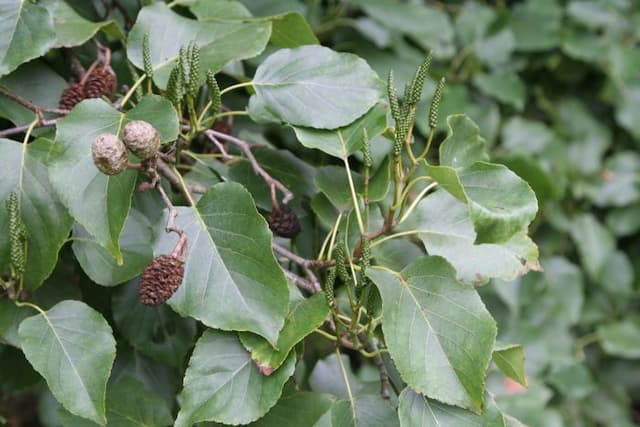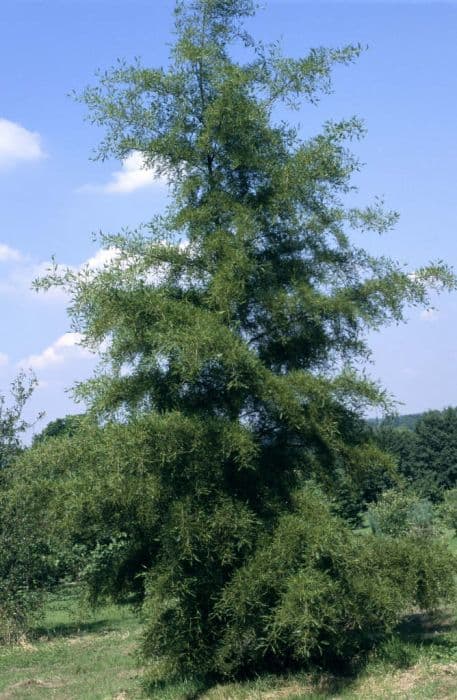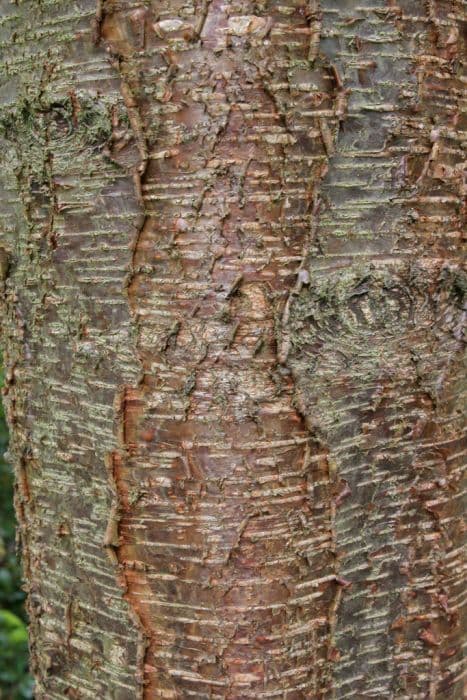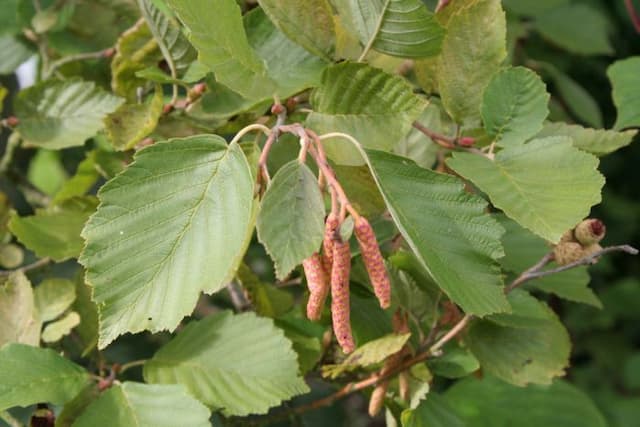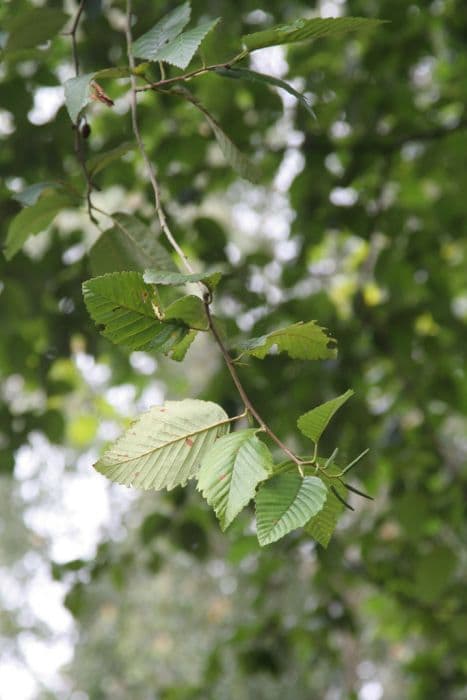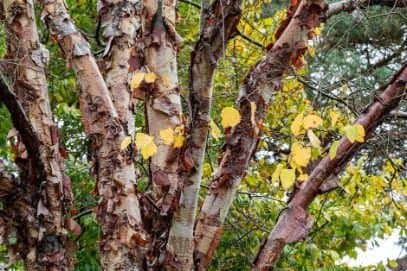Chinese Red Birch Betula utilis subsp. albosinensis (Burkill) Ashburner & Mcall.
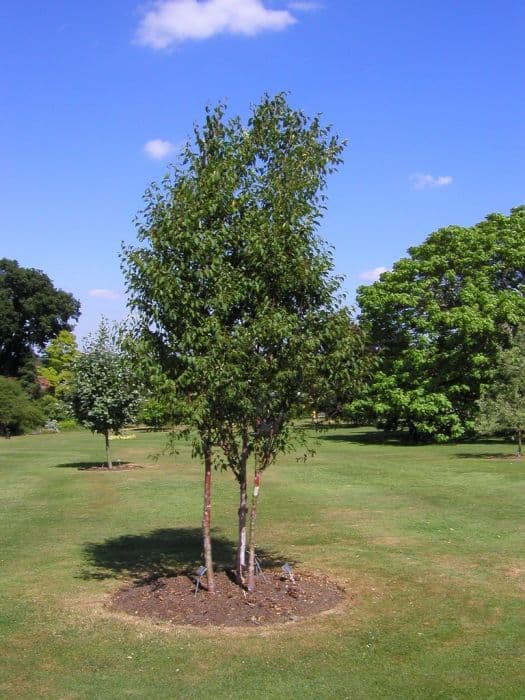
ABOUT
The plant commonly known as the Chinese red birch is recognized for its striking bark and overall elegant appearance. On younger trees, the bark typically shows a rich reddish or coppery tone, peeling off in paper-like layers. As the tree matures, the bark may transition to shades of pink, brown, and cream, providing a truly unique and attractive display throughout different stages of the tree's life. This plant has oval to triangular shaped leaves that are pointed at the tip. The leaves' edges are serrated or toothed, and their surface is a bright, vibrant green, sometimes turning into a splendid display of yellow in the autumn. The Chinese red birch blooms with catkins, which are long, slim clusters of flowers. These catkins appear in both male and female forms, with the male catkins being longer and dangling, creating an attractive floral display. After flowering, small winged seeds are produced, which are usually dispersed by the wind. With its beautiful peeling bark and lush green foliage that turns into a dazzling yellow in the fall, the Chinese red birch is a charming and decorative addition to any landscape, appreciated for its ornamental qualities despite not being noted for its specific dimensions.
About this plant
 Names
NamesFamily
Betulaceae.
Synonyms
Chinese Red Birch, Red Bark Birch.
Common names
Betula albosinensis Burkill, Betula utilis var. albosinensis (Burkill) Rehder, Betula utilis var. septentrionalis P.C.Li.
 Toxicity
ToxicityTo humans
The most common common name for Betula utilis subsp. albosinensis is Chinese Red Birch. Generally, the Chinese Red Birch is not considered toxic to humans. There are no well-documented cases of toxicity or poisoning from ingesting parts of this plant. However, it is always advisable to exercise caution and avoid eating parts of ornamental plants unless they are known to be edible.
To pets
For the Chinese Red Birch, there is no significant evidence suggesting it is toxic to pets. It is not commonly listed among plants that are poisonous to animals like dogs or cats. Nonetheless, it is always best to prevent pets from eating plants that are not intended for consumption, as they might cause gastrointestinal upset or other non-specific symptoms simply due to the ingestion of non-food items.
 Characteristics
CharacteristicsLife cycle
Perennials
Foliage type
Deciduous
Color of leaves
Green
Flower color
Yellow
Height
30 feet 9 inches (10 meters)
Spread
20 feet 6 inches (6 meters)
Plant type
Tree
Hardiness zones
7
Native area
China
Benefits
 General Benefits
General Benefits- Ornamental Value: The Chinese red birch is appreciated for its attractive peeling bark, which adds visual interest to gardens and landscapes in all seasons.
- Shade Provision: Like many trees, it offers shade, making outdoor spaces more comfortable and reducing the need for cooling in adjacent buildings.
- Wildlife Habitat: Provides natural habitat and food sources for various wildlife species, including birds and insects.
- Seasonal Interest: Offers year-round interest with its changing leaf colors in the fall, distinctive bark in the winter, and new growth in the spring.
- Erosion Control: Its root system helps to stabilize soil and prevent erosion, especially in sloped areas.
- Cultural Significance: The tree may hold cultural or symbolic importance in certain regions or amongst certain groups.
- Carbon Sequestration: As with other trees, it absorbs carbon dioxide, thus contributing to the mitigation of climate change.
 Medical Properties
Medical PropertiesThis plant is not used for medical purposes.
 Air-purifying Qualities
Air-purifying QualitiesThis plant is not specifically known for air purifying qualities.
 Other Uses
Other Uses- Traditional crafts: The wood of the Chinese red birch can be used in carving and crafting traditional utensils and decorative items due to its fine grain and ease of working.
- Furniture making: Its appealing wood grain and durability make it valuable for manufacturing high quality, artisan furniture.
- Musical instruments: The resonant qualities of Chinese red birch wood make it suitable for certain parts of musical instruments, such as the soundboards for string instruments.
- Veneer production: The timber can be sliced into veneers for use in cabinetry, paneling, and fine woodworking projects.
- Landscape architecture: Due to its attractive bark and form, it is widely used in ornamental landscaping and park design for aesthetic purposes.
- Tannin extraction: The bark could potentially be used for extracting tannins, which are used in the leather tanning industry.
- Photography: Birch bark has been traditionally used as a background or a textural element in artistic photography due to its unique patterns.
- Culinary smoking: Wood chips from the Chinese red birch can be used to smoke food, imparting a distinct flavor.
- Dye production: The bark may contain compounds useful for natural dye production in textile arts.
- Ink making: Historically, birch bark has been a source of materials for making ink used in manuscripts and drawings.
Interesting Facts
 Feng Shui
Feng ShuiThe Chinese Red Birch is not used in Feng Shui practice.
 Zodiac Sign Compitability
Zodiac Sign CompitabilityThe Chinese Red Birch is not used in astrology practice.
 Plant Symbolism
Plant Symbolism- Resilience: As a subspecies of birch, Betula utilis subsp. albosinensis commonly known as Chinese red birch typically grows in tough conditions and can adapt to various climates, symbolizing the ability to thrive despite challenges.
- Purity: Birch trees often represent purity and cleanliness due to their bright bark and the way they shed their skin, much like a renewal process.
- New Beginnings: The birch tree is one of the first to grow back after a forest fire and is often associated with rebirth and regeneration, marking the start of something new and the promise of better times ahead.
- Protection: In many cultures, birch trees are seen as protective spirits. The Chinese red birch, with its distinctive bark and strong presence, may be seen as a symbol of protection and safeguarding.
 Water
WaterChinese Red Birch should be watered deeply but infrequently to mimic natural conditions and encourage deep root growth. During the growing season, typically a total of 1-2 inches of water per week, including rainfall, is sufficient. Adjust the watering schedule during periods of drought or excessive rainfall. For young trees or those planted in sandy soils, water might be needed twice a week, whereas mature trees in heavier soils may only require additional water every two to three weeks. It's important to avoid overwatering, which can lead to root rot and other issues, so allowing the soil to dry out partially between irrigation sessions is optimal. Water should be applied slowly at the base of the tree, ensuring that it reaches the root zone which may be several inches below the soil surface.
 Light
LightChinese Red Birch thrives best in full sun to partial shade. Ideally, it should receive at least four to six hours of direct sunlight daily. A spot that provides morning sun with some afternoon shade would be favorable, especially in regions with hot summers. Avoid heavily shaded areas, as insufficient light can lead to weak growth and reduced vigor.
 Temperature
TemperatureChinese Red Birch performs well in a range of temperatures and can withstand winter lows to around -20°F while summer highs of up to 80°F are tolerated but not ideal. The tree prefers cooler climates and the ideal temperature range for this birch is between 60°F and 70°F. It is best to avoid exposing the tree to extreme heat or sudden temperature fluctuations.
 Pruning
PruningPrune Chinese Red Birch minimally, mainly to remove dead or diseased branches and to maintain a strong, pleasing shape. The best time for pruning is late winter or early spring before new growth starts, as pruning at this time reduces the risk of sap bleeding, which can attract pests or lead to disease. Periodic thinning out of crowded branches can also help to improve air circulation.
 Cleaning
CleaningAs needed
 Soil
SoilChinese Red Birch thrives in well-draining, sandy loam with a slightly acidic to neutral pH of 5.5 to 7.0. The best soil mix includes loam, organic matter like leaf mold or well-rotted compost, and some sharp sand for improved drainage.
 Repotting
RepottingChinese Red Birch trees planted in containers may need repotting every 2-3 years to prevent root bounding and to replenish soil nutrients.
 Humidity & Misting
Humidity & MistingChinese Red Birch prefers moderate to high humidity levels, typically around 40-60%, to mimic its native woodland habitat.
 Suitable locations
Suitable locationsIndoor
Provide bright light, moist soil, and regular misting for Chinese Red Birch.
Outdoor
Plant in well-draining soil, full sun to partial shade for Chinese Red Birch.
Hardiness zone
6-9 USDA
 Life cycle
Life cycleChinese red birch, a subspecies of Betula utilis, begins its life as a seed, which requires cold stratification to break dormancy before it can germinate, typically in spring. Upon germination, the seedling establishes its root system and grows into a sapling, a stage characterized by rapid vertical growth and the development of foliage. As it matures, the sapling transitions to an adult tree, developing a characteristic peeling white or pink bark, and it begins to reproduce by producing catkins. The male catkins release pollen, which is carried by the wind to fertilize the female catkins, leading to the production of new seeds. The adult Chinese red birch, once fully grown, can reach considerable heights and live for several decades, providing ecological benefits such as habitat and food for wildlife through its life. After reaching the end of its lifespan, the tree will die and decompose, recycling its nutrients back into the ecosystem.
 Propogation
PropogationPropogation time
Spring-Early Summer
Propogation: The Chinese Red Birch, scientifically known as Betula utilis subsp. albosinensis, is often propagated through seed sowing. This method is popular for its simplicity and effectiveness. For optimal results, seeds should be sown in the fall, which allows the cold winter period to naturally stratify the seeds, breaking their dormancy. Alternatively, if spring sowing is preferred, seeds require pre-treatment with stratification, which involves chilling them at 34-40 degrees Fahrenheit (1-4 degrees Celsius) for around 6 weeks, mimicking natural winter conditions. Once stratified, seeds are sown in well-drained, sandy soil and lightly covered, kept moist until germination occurs, which is typically within a few weeks to a couple of months.
